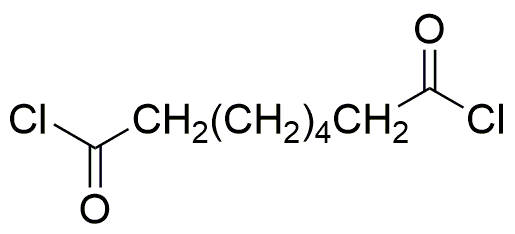Suberoyl chloride is widely utilized in research focused on:
- Synthesis of Polyesters: It serves as a key intermediate in the production of polyesters, which are used in textiles and packaging materials, offering durability and flexibility.
- Pharmaceutical Development: This compound is employed in the synthesis of various pharmaceutical agents, enhancing drug efficacy and stability in formulations.
- Organic Synthesis: Suberoyl chloride is a valuable reagent in organic chemistry for creating complex molecules, facilitating advancements in material science and chemical research.
- Surface Modification: It is used to modify surfaces of polymers, improving adhesion and compatibility in coatings and adhesives, which is crucial in automotive and aerospace industries.
- Research in Biochemistry: The compound is utilized in biochemical studies to explore enzyme interactions and metabolic pathways, aiding in the development of new therapeutic strategies.
General Information
Properties
Safety and Regulations
Applications
Suberoyl chloride is widely utilized in research focused on:
- Synthesis of Polyesters: It serves as a key intermediate in the production of polyesters, which are used in textiles and packaging materials, offering durability and flexibility.
- Pharmaceutical Development: This compound is employed in the synthesis of various pharmaceutical agents, enhancing drug efficacy and stability in formulations.
- Organic Synthesis: Suberoyl chloride is a valuable reagent in organic chemistry for creating complex molecules, facilitating advancements in material science and chemical research.
- Surface Modification: It is used to modify surfaces of polymers, improving adhesion and compatibility in coatings and adhesives, which is crucial in automotive and aerospace industries.
- Research in Biochemistry: The compound is utilized in biochemical studies to explore enzyme interactions and metabolic pathways, aiding in the development of new therapeutic strategies.
Documents
Safety Data Sheets (SDS)
The SDS provides comprehensive safety information on handling, storage, and disposal of the product.
Product Specification (PS)
The PS provides a comprehensive breakdown of the product’s properties, including chemical composition, physical state, purity, and storage requirements. It also details acceptable quality ranges and the product's intended applications.
Certificates of Analysis (COA)
Search for Certificates of Analysis (COA) by entering the products Lot Number. Lot and Batch Numbers can be found on a product’s label following the words ‘Lot’ or ‘Batch’.
*Catalog Number
*Lot Number
Certificates Of Origin (COO)
This COO confirms the country where the product was manufactured, and also details the materials and components used in it and whether it is derived from natural, synthetic, or other specific sources. This certificate may be required for customs, trade, and regulatory compliance.
*Catalog Number
*Lot Number
Safety Data Sheets (SDS)
The SDS provides comprehensive safety information on handling, storage, and disposal of the product.
DownloadProduct Specification (PS)
The PS provides a comprehensive breakdown of the product’s properties, including chemical composition, physical state, purity, and storage requirements. It also details acceptable quality ranges and the product's intended applications.
DownloadCertificates of Analysis (COA)
Search for Certificates of Analysis (COA) by entering the products Lot Number. Lot and Batch Numbers can be found on a product’s label following the words ‘Lot’ or ‘Batch’.
*Catalog Number
*Lot Number
Certificates Of Origin (COO)
This COO confirms the country where the product was manufactured, and also details the materials and components used in it and whether it is derived from natural, synthetic, or other specific sources. This certificate may be required for customs, trade, and regulatory compliance.


